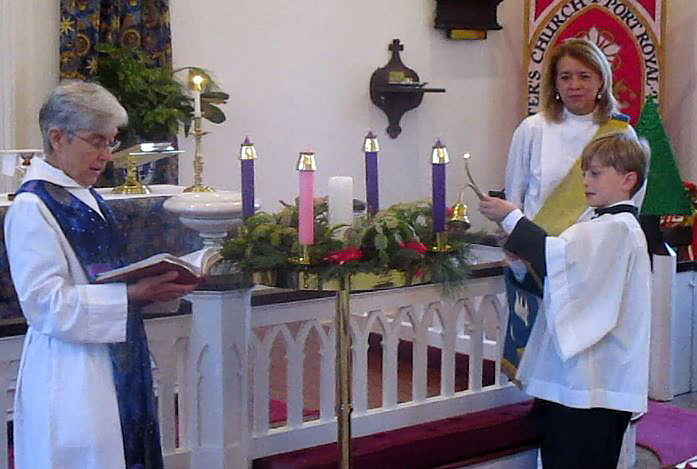
The first Sunday of Advent is one of change. A change to the altar in color; a change in the year – Advent is the first Sunday in the church year where this year we shift in the lectionary from Year C (Luke) to Year A (Matthew). A change in focus since Advent means to come:
The Coming of God to the world as a human baby
The Coming of God to the world in His glory at the end of time where God’s purposes will be fulfilled
The Coming of God into the world today. Jesus comes to us now in word and sacrament, in prayer and praise, in his Body, the Church. By the work of the Holy Spirit, the Jesus who was born in the past in Bethlehem and who will come in the future is present to us and in us now.
The altar colors changed to blue, the altar flowers were green
In a timing of coming, the Gospel this week emphasizes the need to prepared for future events. Isaiah envisions a time of full justice when all nations honor God and live in peace. In Romans, Paul reminds us that the nearness of our salvation enables us to love selflessly and live honorably. Paul asserts that the greatest motivation for the Christian’s moral life lies in the future–the Christ’s second coming. The end of time is near at hand. The great day of salvation is coming–sleep/night/darkness will give way to waking/day/light.
In Matthew’s Gospel the season of Advent begins with a look to the future coming (parousia of the Son of Man. Chapters 24–25 are the last of the five major speeches that Jesus gives. They center upon the last days and the expectation of the coming of the Son of Man. Today’s section focuses on the theme of preparedness. The “Son of Man” likely references the human-like divine being named in one of the apocalyptic visions found in Daniel 7:13 (Aramaic bar enash — “human being” — lit. “son of man”), a text that figured prominently in first-century Jewish and early Christian apocalyptic thought. For Matthew, this is a title that represents Jesus as the divinely chosen human agent who ushers in the end times. The warnings here against lack of awareness balance those earlier that caution against overzealous or premature expectations of the coming.
Jesus’ coming will bring judgment, not upon sin, but upon one’s state of readiness. The division made by God betwen the ready and the unready cuts across all human categories. The eternal choice may occur at any moment, therefore constant watchfulness is needed.
While we typically live with a fairly linear view of time — one event coming after another — the church’s liturgical and lectionary calendar is cyclical — patterns of events repeating themselves. For this reason, the church year that begins in Advent puts in front of us passages about the end of history before moving in later weeks to prepare us for the coming of the Christ child and the dawn of a new age.
There are many ways to group the lectionary. Here we look at it as a form of invitation to await the Christ child
Another way is to group it around the 5 candles on the Advent wreath.
1. God’s people -The Candle of Hope.
Hope is like a light shining in a dark place. As we look at the light of this candle we celebrate the hope we have in Jesus Christ.
As the theologian Richard Rohr puts it, long after Christmas is past, our “assured shout of cosmic hope—‘Come, Lord Jesus’ is “a leap into the kind of freedom and surrender that is rightly called the virtue of hope.”
Rohr says that “the theological virtue of hope is the patient and trustful willingness to live without closure, without resolution, and still be content and even happy because our Satisfaction is now at another level, and our Source is beyond ourselves.”
2. The old testament prophets – The Candle of Peace
Peace is like a light shining in a dark place. As we look at this candle we celebrate the peace we find in Jesus Christ.
John the Baptist
3. The Candle of Love
Love is like a candle shining in a dark place. As we look at the light of this candle we celebrate the love we have in Christ.
4. Mary the mother of Jesus – The Candle of Joy
Joy is like a light shining in a dark place. As we look at this candle we celebrate the joy we find in Jesus Christ.
The fifth candle represents the birth of Christ.
The flame of this candle remind us that He is the light of the world and that if we follow Him, we will never walk in darkness, but will have the true light of life.Some conclusions to the readings of Advent 1:
Know what time it is!
Put on the armor of light!
Get up the nerve to use that ticket and go on that journey to the house of the Lord!
Walk in God’s paths!
Stay awake and alert and be ok with the mystery of God’s timing!
But most of all, carry the light of Christ with you at all times, the light that shines in the darkness –and the darkness cannot overcome it.
One last thing—now that Advent is finally here, let’s give a shout out to this season of hope—“our assured shout of cosmic hope…” “Come, Lord Jesus!”
